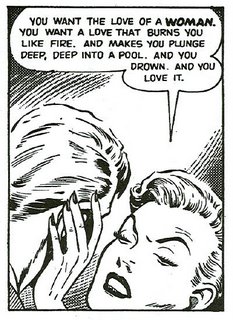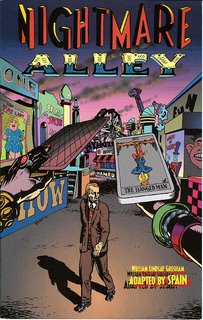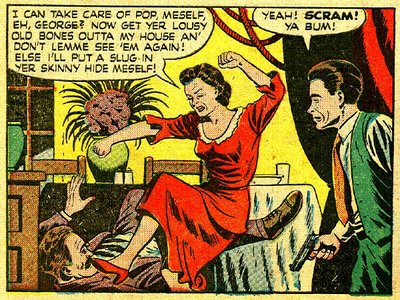It Rhymes With Lust
The Comics Journal did a gutsy thing by using 63 pages to reprint the 1950 Picture Novel, It Rhymes With Lust, in their latest issue, #277.
There are a couple of articles by Michael T. Gilbert and Ken Quattro giving the history of It Rhymes With Lust, a novel written by "Drake Waller," (pseudonyms of Leslie Waller and Arnold Drake). Reading about an old experiment in comics is different than seeing it. So it was great that TCJ decided to print the whole thing, and let the readers decide whether it qualifies as the first graphic novel.
It Rhymes With Lust was originally printed in black and white with color covers, in a format halfway between a paperback book and comic book. It reminded me of common black-and-white comics printed in Europe, of which I have a few. I'm not sure which came first, the Euro comics, or It Rhymes With Lust, but like any idea, it probably had several incarnations in different places, some more successful than others.
In his TCJ article about the book, Michael T. Gilbert describes the plot as akin to a "B-movie potboiler," which it was. That was probably one of the problems with it; it stuck too close to what was already being seen, both in movies and paperback books. Matt Baker, the artist, was closely associated with romance comics, so it had something of a romance comic feel. That was OK for luring in females to buy it. I just wonder if it worked. Obviously not enough people bought it, since the format was killed after one more experiment (a mystery called Case Of The Winking Buddha, with art by Charles Raab).
I'm including examples of a couple of panels from It Rhymes With Lust, which show that some of the dialogue was strictly from an author's imagination, and nothing anyone would say in real life, or even in a movie. Only in a comic book could you get a line that says, "By the god that made me!" instead of something like, "Goddam it!"

 I'm not advocating the use of swearing, but probably throwing in a couple of hells and damns might have made the novel seem more adult, more apart from the movies and color newsstand comic books it was inspired by.
I'm not advocating the use of swearing, but probably throwing in a couple of hells and damns might have made the novel seem more adult, more apart from the movies and color newsstand comic books it was inspired by.A couple of years ago, Fantagraphics, publisher of The Comics Journal, published a graphic novel version of Nightmare Alley, drawn by Spain Rodriguez, an interpretation of the popular noir novel and movie of the late 1940s. This is more of what I think the book It Rhymes With Lust could have and should have been: an earthier, sexier, tougher book by far than the half-wimpy but prettily illustrated black-and-white comic book it was.

Michael Gilbert found his copy of It Rhymes With Lust on the top shelf in a Powell's bookstore. My fantasy would be to be digging around Powell's and find a 1950 graphics novel version of Nightmare Alley, drawn by EC Comics great Graham Ingels, who would have been the perfect artist for that book. I'm allowed to dream about it, anyway.




































